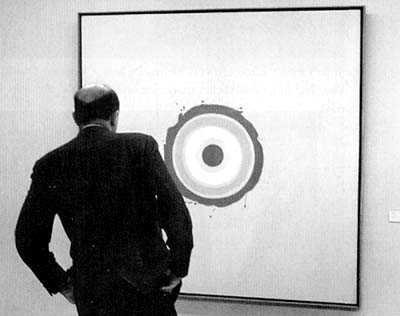In my “Sightings” column for today’s Wall Street Journal I report on a recent visit to the Portland Art Museum’s Clement Greenberg Collection, and reflect on how Greenberg’s willingness to accept gifts of paintings and sculpture from the artists about whom he wrote has compromised his posthumous reputation. I also have a few sharp words to say about Virgil Thomson, a critic who–unlike Greenberg–really could be bought. Here’s a preview.
* * *
Most critics, like the artists about whom they write, are forgotten soon after they die, if not long before. But Clement Greenberg, whose fervent advocacy put Jackson Pollock on the art-world map, is still well remembered at Oregon’s Portland Art Museum. The Clement Greenberg Collection, on display in Portland since 2001, consists of 155 paintings, sculptures and works on paper by five dozen of the critic’s favorite artists, among them Pollock, Richard Diebenkorn, Helen Frankenthaler, Hans Hofmann, Kenneth Noland, Jules Olitski and David Smith. The installation takes up the better part of a floor, and the best pieces, such as Noland’s “No. One” (1958) and Frankenthaler’s “Spaced Out Orbit” (1973), are spectacular reminders of how Mr. Greenberg, writing in the pages of Partisan Review, The Nation, and other small-press magazines, helped to persuade a generation of Americans that abstract art was the wave of the future.
 In his lifetime, Greenberg’s art collection was so admired that Vogue ran a story in 1964 that was illustrated by glossy photographs of his Manhattan apartment, whose walls were covered with paintings. It was quite a sight to see—but it led certain savvy readers to wonder how an art critic, even one as celebrated as Greenberg, had managed to assemble a 155-piece collection of works by some of the most famous American artists of the 20th century. Was he rich? Far from it. The works in his collection were all presented to him as gifts by the grateful artists about whom he wrote. Not only did he accept such gifts, but he sold them whenever he needed money—and after his death in 1994, Greenberg’s widow sold the remaining works in his collection to the Portland Art Museum for two million dollars.
In his lifetime, Greenberg’s art collection was so admired that Vogue ran a story in 1964 that was illustrated by glossy photographs of his Manhattan apartment, whose walls were covered with paintings. It was quite a sight to see—but it led certain savvy readers to wonder how an art critic, even one as celebrated as Greenberg, had managed to assemble a 155-piece collection of works by some of the most famous American artists of the 20th century. Was he rich? Far from it. The works in his collection were all presented to him as gifts by the grateful artists about whom he wrote. Not only did he accept such gifts, but he sold them whenever he needed money—and after his death in 1994, Greenberg’s widow sold the remaining works in his collection to the Portland Art Museum for two million dollars.
Nobody who knew the famously outspoken Greenberg at all well believed that his critical judgment could be swayed by giving him a painting. Moreover, the now-famous artists whom he championed were unknown when he first wrote about them, meaning that their work had little or no monetary value. But in the hard-nosed world of journalism, appearance and reality are inseparably entwined, and today the Greenberg Collection looks less like an eloquent tribute to the sharp eye of a great critic and more like a glaring conflict of interest….
* * *
Read the whole thing here.
Terry Teachout on the arts in New York City
